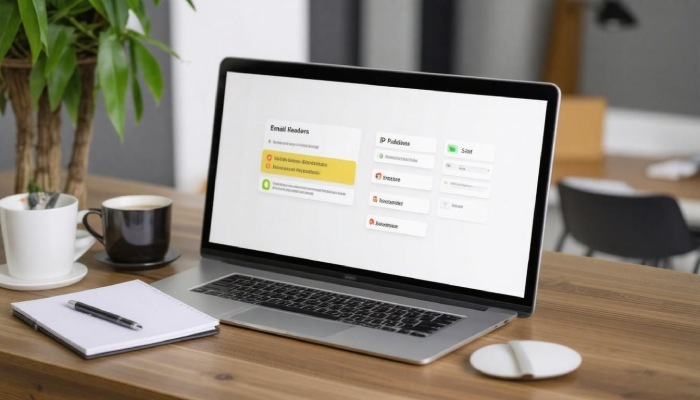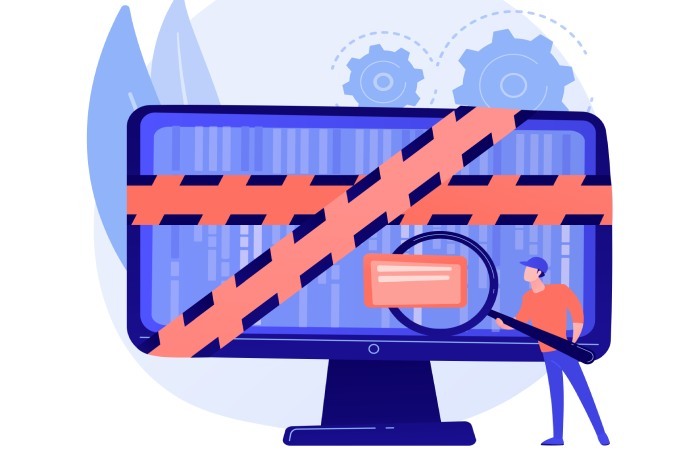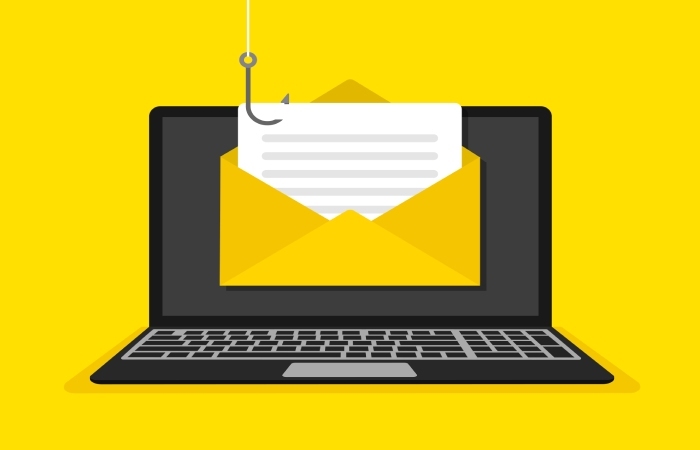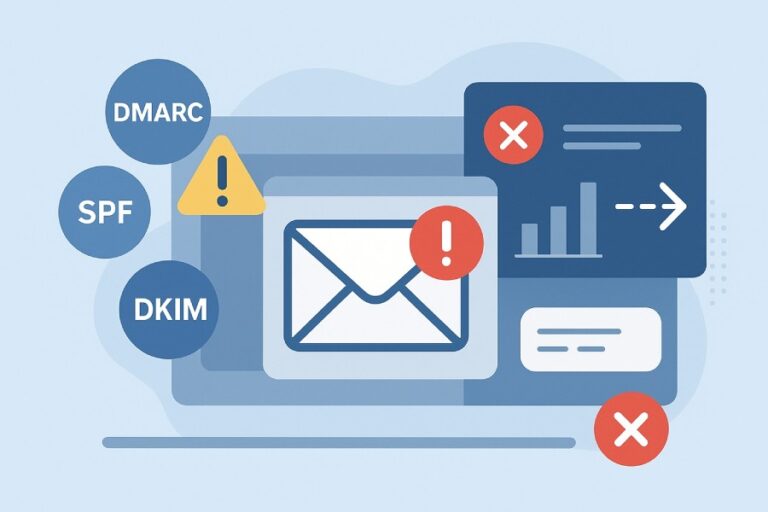Email Header Analyzer: Effective Software to Detect Spam
In a world where emails pop into our inboxes like unsolicited party invites, understanding how to sift through them effectively is more crucial than ever. Ever received a message that looked totally legit but left you questioning its true origins? That’s the problem many people face. As cybercriminals get cleverer, distinguishing between authentic communication and digital trickery becomes a vital skill. An email header analyzer emerges as the secret weapon at your disposal—unveiling the hidden details of an email’s journey while helping you dodge potential scams. In this article, we’ll explore what these tools are, how they work, and why they’re essential for keeping your inbox safe and sound.
An email header analyzer is a tool that decodes the complex information contained within email headers, allowing users to trace the origins of an email, identify potential spam messages, and assess the delivery paths taken. By using these analyzers, you can gain insights into delays, anti-spam results, and security risks associated with your emails, ultimately helping you safeguard your inbox.
What is an Email Header Analyzer?
An email header analyzer is a powerful tool that digs into the metadata within an email’s header. While many may skim over this part of an email, thinking it too technical or irrelevant, these headers hold valuable information. By using an analyzer, you can reveal insights about where the email originated, how it traveled from sender to recipient, and any security checks it underwent along the way.
Imagine opening an email is like receiving a letter through traditional mail. Just as you’d look at the envelope for clues about the sender and route taken, an email header behaves similarly. It lists critical details such as the sender’s address, recipient’s information, timestamps indicating when each server handled the message, and authentication results helping determine if the email was altered in transit. A well-designed analyzer transforms this confusing data into a comprehensible format.
Without these headers, spotting issues—like phishing attempts or spoofed emails—could feel nearly impossible. Cybercriminals craft emails that mimic legitimate ones with precision. They can easily fake their display name or embed harmful links beneath seemingly harmless text. The header provides verification tools to combat this reality.

Key components analyzed include “Received” fields that show every mail server involved during transmission, “DKIM-Signature” validations that confirm the message’s authenticity, and “From” addresses to scrutinize legitimacy. For example, consider the “Received” field; it’s incredibly revealing about your email’s journey. Every server it passes through is logged here, providing a timeline of its travels across networks.
Some aspects to keep an eye on when analyzing headers include:
- The originating IP address: This reveals where the email came from and can indicate suspicious activity if it’s from a known bad actor.
- Timestamps: These indicate how long the email took to travel through different servers, revealing potential delays.
- Spam keys: Many analyzers flag red flags directly related to spam detection.
As we transition from understanding what email header analyzers can do, let’s explore the essential elements that enable these tools to effectively identify threats and protect your digital communications.
Key Features for Detecting Spam
Identifying spam is one of the primary functions of any email header analyzer, and understanding its key features can significantly improve your ability to filter out unwanted emails. For starters, hop delays are an indispensable aspect of the analysis. These measurements tell you how long an email takes at each server it passes through during delivery. If you notice unusual delays—especially if they exceed what’s typical—this might signal some suspicious activity. It’s akin to spotting a suspicious character hanging around your mailbox; something’s off, and it deserves further investigation.
In addition to hop delays, another crucial feature is the spam score assigned by sophisticated algorithms during header analysis.
This numerical score gauges the likelihood of an email being spam. Factors contributing to this calculation include sender reputation, content analysis, and anomalies detected within the header itself. Picture it like a grading system: the lower the score, the higher the chance of that email being legitimate. It’s your first line of defense against potential scams and phishing attempts.
Complementing these features are authentication results, which play a pivotal role in confirming the legitimacy of incoming emails.

These results verify whether an email complies with standards such as DKIM (DomainKeys Identified Mail) and SPF (Sender Policy Framework) records. Think of this as your email’s ID card; if it doesn’t check out, then it’s wise to be cautious. This authentication process significantly reduces the chance of falling victim to spoofed emails pretending to be from trusted sources.
Another integral component is IP address tracking, which aids in pinpointing the origin of the email.
By tracking the originating IP address, users can identify if it’s associated with known spam servers. Imagine having a map in front of you that highlights criminal hotspots; this feature does just that for your email communications, allowing you to easily discern whether an email falls within a risky area.
To further enhance security, many analyzers incorporate blacklisting checks.
This feature cross-references IP addresses and domains against databases of known offenders—essentially creating a safety net to catch malicious actors before they reach your inbox. If an IP appears on such lists, it raises an immediate red flag, giving you the power to make informed decisions about whether or not to engage with the sender.
These layers of protection are vital in our increasingly digital world where cyber threats lurk at every corner.
A well-rounded email header analyzer contributes greatly to overall email security by leveraging these features. From mitigating risks posed by possible spam to validating authenticity through robust authentication methods, these tools serve as indispensable allies in managing our digital communications effectively.
Understanding these crucial elements lays a solid foundation as we examine what happens behind the scenes in this crucial aspect of communication security.
How Email Header Analyzers Work
At the heart of every email header analyzer is a process that takes what is typically a complex string of information and transforms it into clear, actionable data. When you submit an email header into the analyzer, the software begins its work by meticulously breaking down the header line-by-line. This dissection is akin to a forensic investigation where each piece of information plays a crucial role. The analyzer utilizes a combination of databases and sophisticated algorithms to identify any discrepancies and potential threats.

Step-by-Step Process
The first part of this process involves data collection. Here, the analyzer extracts all relevant header data including timestamps that indicate when the email was sent, server paths that show how it traveled from sender to recipient, and authentication details like SPF , DKIM or DMARC records. Each piece contributes essential context regarding the email’s origin and integrity. This stage is similar to gathering evidence at a crime scene—every detail matters.
After collecting this vital information, the next step is analysis.
During analysis, every extracted item is examined against known standards and databases. For instance, if an IP address appears that doesn’t match the sender’s domain or fails the DKIM check, these anomalies are immediately flagged for further examination. This careful comparison serves as a filter through which only legitimate emails should pass. By treating every piece of data with scrutiny, email header analyzers help identify potential threats amidst a sea of seemingly innocuous messages.
Reporting
Once the analysis is complete, we arrive at reporting. This final step compiles everything learned into an understandable format for the user, often resulting in a spam score along with an explanation of findings and recommendations on how to proceed. Imagine receiving not just a verdict on whether an email is spam but also intelligence on why it was flagged and how to protect yourself moving forward. This empowerment through knowledge can be invaluable in navigating personal and professional communications.
By leveraging these powerful tools, both individuals and businesses gain a comprehensive view of an email’s potential threats, enabling informed decisions about day-to-day communication to overall security protocols. Understanding how these analyzers function is essential for enhancing your ability to filter unwanted emails while significantly bolstering your cybersecurity defenses. As we transition to examining more intricate issues related to recognizing deceptive messages and tactics used in digital correspondence, it’s crucial to remain vigilant.
Identifying Fake Emails and Spoofing
Fake emails, commonly referred to as spoofed emails, are designed to mimic trusted sources in order to deceive recipients. At its core, spoofing involves falsifying the “From” address, presenting an illusion that the email originates from a legitimate sender. This type of fraud can lead unsuspecting individuals to divulge sensitive information or click malicious links, creating significant vulnerabilities.

For instance, imagine receiving an email that appears to be from your bank, complete with logos and official language urging you to update your account details. Looks convincing, right? However, within that email may lurk malware aimed at stealing your personal information. This is precisely why tools like email header analyzers are vital; they aid users in spotting these threats through detailed examination of various components within the headers.
By checking elements such as the “Return-Path,” these analyzers reveal the true journey of an email and highlight inconsistencies between what’s displayed and where it really came from.
Detecting Signs of Spoofing
Identifying spoofed emails typically requires keen attention to detail. Some notable signs to look out for include mismatched header information. For example, if the email claims to be from a reputable company yet shows an IP address from a country where that company does not operate, this discrepancy should raise red flags.
Additionally, you may notice other warning signals:
- Mismatched Header Information: Check for inconsistencies between the supposed “From” address and the actual originating server’s IP.
- Missing Authentication: Genuine emails typically have valid DKIM (DomainKeys Identified Mail) or SPF (Sender Policy Framework) records. If these records are absent, there’s a strong chance of deception.
- Unexpected Routing Paths: Emails that travel through servers known for fraudulent activity deserve scrutiny.
With rising cyber threats and an alarming increase in phishing attempts—90% of which initiate via email—it’s essential that users familiarize themselves with these indicators of spoofed emails. Understanding these nuances can be crucial in safeguarding your online interactions and protection strategies as we further explore their broader implications in cyberspace.
Importance for Cybersecurity
Email header analyzers are indispensable tools in modern cybersecurity strategies. By breaking down the journey and components of an email, these analyzers play a vital role in identifying suspicious activity that might otherwise go unnoticed. Just consider this: according to a 2024 report by Cybersecurity Ventures, phishing attacks account for 90% of all data breaches. With figures like that, it’s clear that not taking this seriously can have significant repercussions.
One of the primary benefits of email header analyzers is their ability to catch spam and spoofed emails before they ever reach a user’s inbox. This proactive approach prevents potential exposure to malware, ransomware, and scams, allowing you to breathe easier knowing your personal information and organizational data remain protected from prying eyes. Imagine protecting your valuable data with a simple click while filtering out threats.

Regular maintenance, such as updating the analyzer’s database ensures its effectiveness against new and emerging threats. Failing to keep up with updates could render your analyzer obsolete against increasingly sophisticated phishing techniques.
Enhanced Threat Detection
But how does it work? When an email arrives, its headers contain crucial metadata illustrating how the message traveled across various servers, alongside unique identifiers revealing if the sender is genuine or fraudulent. Analyzers parse this data according to standards set by RFC 822, transforming it into a human-readable format which allows users to quickly evaluate its legitimacy. By pinpointing indicators such as hop delays and anti-spam results, you arm yourself against malicious activities.
Furthermore, should a communication appear suspicious based on header analysis, action can be taken swiftly. This might mean marking an email as spam or even alerting IT security teams within organizations who rely on efficient handling of threats. Having an efficient email header analyzer is akin to having an extra layer of protection guarding your digital front door.
An often overlooked aspect in many organizations is employee training on using these tools effectively. By educating all staff members on interpreting header analysis results and recognizing fake emails, organizations can often prevent breaches before they happen.
It’s worth noting that 60% of IT professionals believe that email header analyzers are essential for identifying and mitigating spam threats. Given this statistic, it’s reasonable to consider why these tools ought to be part of every organization’s cybersecurity toolkit.
To further emphasize the importance of staying informed on cybersecurity trends: recent surveys indicate that 70% of organizations experienced phishing attacks in 2023. Regularly utilizing email header analyses could reduce spam exposure by up to 80%, thus improving overall cybersecurity measures tremendously.
As we transition into exploring specific resources available for analyzing email headers, it becomes clear just how critical these functionalities are for individuals and organizations alike striving to maintain secure communication channels.
Top Tools for Email Header Analysis
When it comes to scrutinizing email headers, having the right tools is essential. A variety of options cater to different needs and technical skills. Using these tools efficiently can help you understand the intricacies of an email’s journey, revealing its authenticity or indicating potential spam.
Leading Options
One standout tool is MXToolbox, which has earned a reputation for its user-friendly interface. It’s like having a Swiss army knife for email analysis at your fingertips. With MXToolbox, you can perform a comprehensive header analysis without needing advanced technical knowledge. The tool simplifies the complexities of email tracing and provides clear insights into any red flags that may appear in an email’s path.

Many users find MXToolbox particularly appealing because it offers extensive features that guide them through each step of the analysis process, making it a great starting point for those unsure about how to approach email headers.
Next up is Google’s Message Header Analyzer, tailored specifically for G Suite and Gmail users. It integrates seamlessly with Gmail, allowing you to simply copy and paste an email header directly into the tool for immediate analysis. This analyzer provides detailed breakdowns of information such as sender IP addresses and timestamps, offering invaluable context about where an email originated. By using this tool, Gmail users can be proactive in discerning whether emails are legitimate or potentially harmful.
Another excellent option is SpamCop, which focuses on reporting and combating spam. If you find yourself constantly targeted by spam campaigns, SpamCop offers an intuitive platform for reporting dubious emails while also helping you understand why certain messages may have landed in your inbox. This dual functionality empowers users to tackle spam while educating themselves on recognizing patterns that indicate fraudulent messages.
While these tools serve as excellent starting points, considering your specific needs and technical comfort level when selecting an analysis solution will enhance your ability to safeguard against phishing attempts or identify suspicious emails. As you weigh your options, the next section will guide you in selecting the most suitable software for your requirements.
Choosing the Best Software
The best software for analyzing email headers truly hinges on your unique requirements and familiarity with email technology. Just like picking out the right tool for fixing a car, you’ll want one that fits the job while matching your skill set. So let’s explore several key considerations to help you make an informed choice.
Considerations
When selecting an email header analysis tool, start by considering how often you’ll rely on its features. If you’re simply looking for occasional insights into email tracking or delivery issues, a basic tool may suffice. However, if you regularly deal with problems related to spam filtering or advanced analytics, opting for a more comprehensive software solution will save you time.
Now that we’ve established this foundational understanding, let’s explore how the user interface can directly affect your experience.

User Interface
An intuitive user interface (UI) is crucial, especially for those new to email header analysis. A simpler UI, like that offered by MXToolbox, is exceedingly helpful for beginners who might be overwhelmed by complex data. This platform makes it easy to read and understand headers without getting lost in technical jargon. In contrast, tools such as Emailheaderanalyzer.com provide richer datasets and deeper insights for experienced users who crave detailed analysis.
Remember: A user-friendly interface reduces frustration, empowering you to focus on interpreting results rather than trying to navigate the software.
Now let’s pivot our focus towards another critical aspect of choosing effective software: database regularity.
Database Regularity
You’ll want to ensure that any tool you choose maintains an up-to-date database. Cyber threats evolve rapidly, and having access to current information can significantly improve your ability to identify malicious emails or improper routes. Therefore, a program that regularly refreshes its database is vital. Tools with historical data gathered from recent spam attacks can provide invaluable context about what’s present on a specific network or server over time.
Look for user reviews or documentation that detail update frequencies and whether the program adapts swiftly to emerging trends within the cybersecurity landscape.
Lastly, we cannot overlook the importance of functionality regarding integration features.
Integration Features
If you’re working within an established email system like G Suite or Outlook, consider how well potential software integrates with these platforms. Seamless functionality means less hassle; syncing background checks on emails should be effortless while enhancing your existing workflow.
Choose tools that offer API access or direct integrations allowing for real-time checking of incoming messages without needing multiple logins or switching between tabs constantly. This saves time during crucial moments when you need to act quickly against possible threats.
Balancing ease of use with comprehensive functionality ensures you make informed decisions while maximizing the effectiveness of your analyses.
In a world where cyber threats persistently evolve, investing time in finding the right email header analysis software can greatly enhance your security measures and efficiency. Your proactive approach now could save you significant troubles later on.
Are there any limitations to using an email header analyzer when identifying spam or malicious emails?
Yes, there are limitations to using an email header analyzer for identifying spam or malicious emails. While these tools can effectively reveal the sender’s information, routing details, and potential red flags, they may not detect all sophisticated phishing attempts that employ social engineering tactics. According to a report by the Anti-Phishing Working Group, 86% of organizations experienced phishing attacks in 2023, highlighting that reliance solely on header analysis could leave users vulnerable to cleverly disguised threats that bypass traditional detection methods.

What key components are included in an email header, and how can they be interpreted?
An email header contains key components such as the “From,” “To,” “Subject,” “Date,” and “Return-Path” fields, along with technical details like the IP address of the sender and the mail servers that processed the email. By analyzing these components, one can determine the legitimacy of an email; for instance, a mismatch between the “From” address and the “Return-Path” may indicate spam or phishing attempts. According to surveys, around 85% of global email traffic is reportedly spam, so effective header analysis is crucial for filtering out unwanted messages and protecting users from scams.
How can I verify if an email is legitimate using an email header analysis?
To verify if an email is legitimate using email header analysis, start by examining the ‘From’ address and the ‘Return-Path’ to check for discrepancies, as spam emails often use spoofed addresses. Additionally, analyze the ‘Received’ lines to trace the email’s path; legitimate emails will show a consistent flow from known servers. According to recent studies, roughly 80% of phishing attempts can be identified through such analysis, making it a valuable tool in distinguishing between genuine and fraudulent communications.
What are some common signs of spoofing or phishing found in email headers?
Common signs of spoofing or phishing in email headers include discrepancies in the “From” address, where the sender’s name may appear legitimate but the actual email is from a suspicious domain. Look for mismatched IP addresses that don’t match the region of the sender and unusual routing paths that deviate from typical sources.
According to a report by the Anti-Phishing Working Group, over 74% of organizations have encountered phishing attacks through email headers, highlighting the importance of vigilant analysis. Additionally, any odd timestamps or abnormal sending patterns can also indicate deceitful activity.
How do different email services format their headers, and will an analyzer work uniformly across all platforms?
Different email services, such as Gmail, Outlook, and Yahoo, format their headers with variations in fields and order, which can affect how an email header analyzer interprets the data. For instance, Gmail may add additional information about security features that might not be present in other services.
Consequently, while many analyzers are designed to handle these discrepancies effectively, inconsistencies across platforms mean they may not work uniformly in all cases. Research shows that 27% of spam emails evade standard filters due to these formatting differences, indicating the need for adaptable analyzers that can account for each service’s unique structure.







